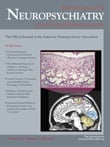To the Editor: Alzheimer’s disease is a progressive neurodegenerative disease, manifested by cognitive and memory deficits that impair daily activities and cause a variety of psychiatric and behavioral disturbances.
1 Many risk factors have been proposed, which, due to some cellular and subcellular mechanisms, finally lead to brain nerve apoptosis.
In Alzheimer’s disease, signs of inflammation of microglia and astroglia are present inside and outside amyloid deposits. It has been shown that there is a relationship between inflammation, reduction of neuronal functions, and deposition of amyloid. In addition, epidemiological studies have shown that anti-inflammatory drugs could reduce the risk of Alzheimer’s disease.
2The p38 mitogen activated protein kinase (p38 MAPK) is a stress-activated enzyme responsible for transducing inflammatory signals and initiating apoptosis. The activation of this kinase is associated with neuritic plaques and neurofibrillary tangles.
2 The c-Jun
N -terminal kinase 3 (JNK3) causes tau phosphorylation and finally leads to the formation of neurofibrillary tangles.
3 The neuritic plaques and neurofibrillary tangles are involved in the pathogenesis of Alzheimer’s disease.
Arsenic and its compounds are used in pesticides, insecticides, herbicides, and some kinds of alloys. Non-occupational sources of arsenic include contaminated food, water, air, and cigarette smoking.
4,
5Workers in industries that use or produce arsenic or arsenic compounds are at risk of exposure. Consumers can be exposed to arsenic or arsenic compounds in the air from production and processing facilities, such as copper and lead smelters, wood treatment plants, and coal burning power plants. Consumers may also be exposed to arsenic or arsenic compounds when using consumer products such as pesticides, fungicides, weed killers, preserved wood, and wood treatment products. If wood that has been treated is burned in a fireplace or wood-burning stove, it is possible to create acute toxic levels of arsenic products in the air of the home.
Arsenic can induce apoptosis in cortical neurons of rats. This process is based on the activation of JNK3 and p38 MAPK by arsenic.
5 According to above-mentioned information, arsenic can activate the p38 MAPK and JNK3, which may cause brain neuronal apoptosis and lead to Alzheimer’s disease. Therefore, using protective masks and improving work atmospheric conditions are necessary for reducing the exposure to this environmental hazard.

